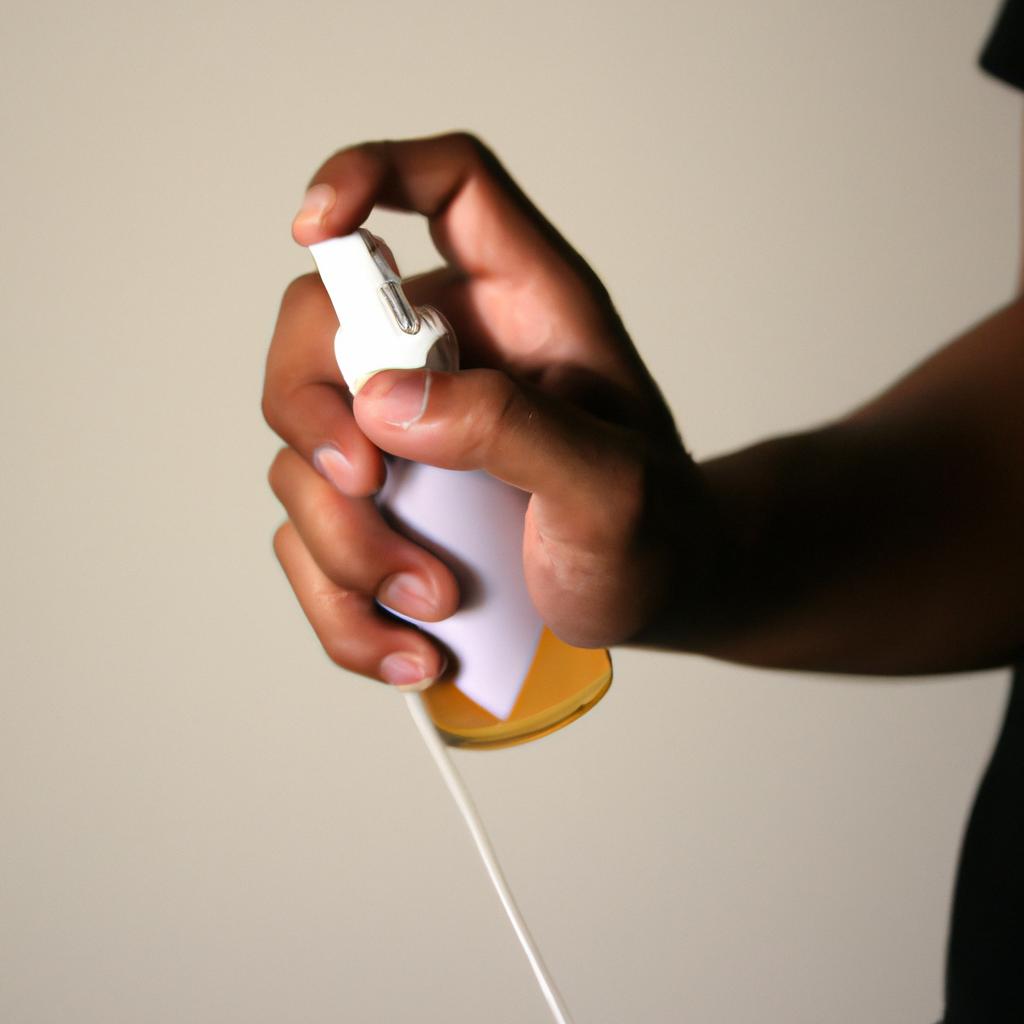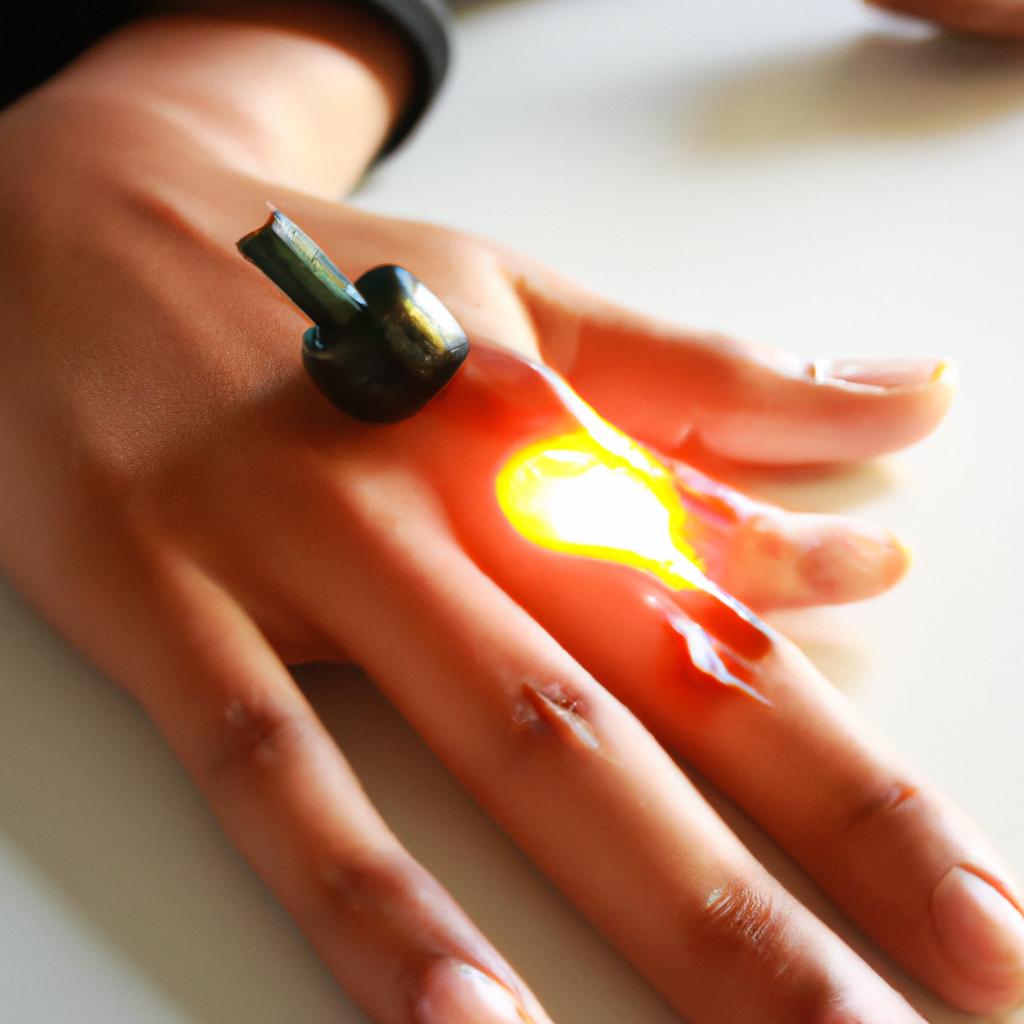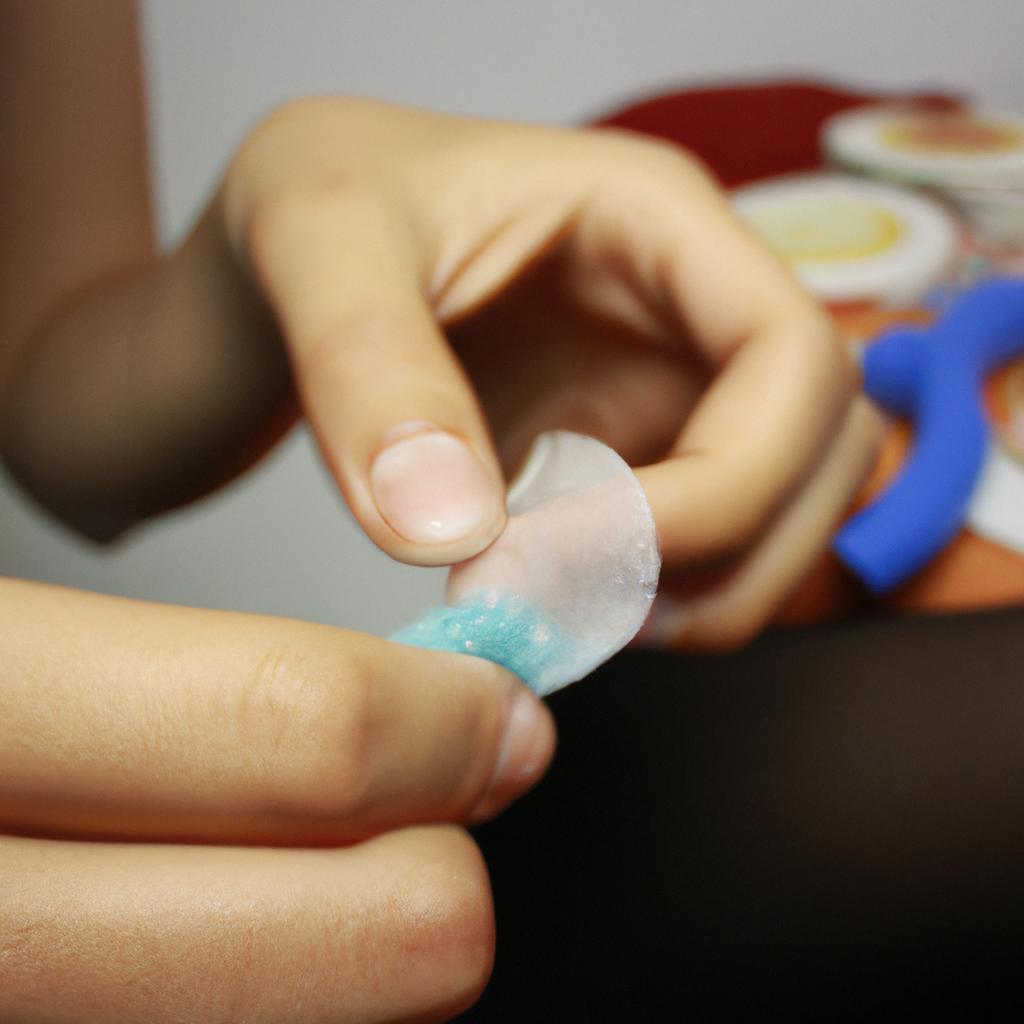In the field of first aid, maintaining cleanliness and hygiene is paramount to prevent infection and promote healing. One effective method for achieving this is through the use of disinfectant sprays. These sprays are specifically designed to kill or inhibit the growth of microorganisms on instruments and supplies, reducing the risk of contamination. For example, imagine a scenario where an individual sustains a deep cut while hiking in a remote area with limited access to medical facilities. In such situations, having a reliable disinfectant spray can significantly reduce the chances of infection by sterilizing any tools used during wound treatment.
Disinfectant sprays not only provide convenience but also offer an essential layer of protection against potential pathogens. By utilizing these sprays, healthcare professionals, as well as individuals providing first aid at home or in emergency situations, can ensure that their instruments and supplies remain free from harmful bacteria, viruses, and fungi. Furthermore, using disinfectant sprays helps maintain sterile conditions during procedures like wound cleaning or suturing, preventing cross-contamination between patients or even within different areas of the body.
Overall, incorporating disinfectant sprays into first aid practices plays a vital role in promoting optimal hygiene standards and minimizing the risk of infections. This article aims to explore the various aspects of disinfectant sprays in first aid, including their effectiveness, types available, proper usage guidelines, and potential side effects. By understanding these key factors, individuals can make informed decisions regarding the use of disinfectant sprays to enhance their first aid practices and ensure optimal cleanliness and safety.
Why Use Disinfectant Spray for Medical Instruments?
Imagine a scenario where you or someone you know has suffered from a minor injury, such as a cut or scrape. In this situation, it is crucial to ensure that the instruments and supplies used in providing first aid are clean and free from harmful bacteria. One way to achieve this is by using disinfectant spray specifically designed for medical instruments.
Using disinfectant spray offers several advantages when it comes to maintaining cleanliness and hygiene in first-aid practices. Firstly, it effectively kills germs and microorganisms on the surfaces of medical tools, preventing their transfer onto wounds or sensitive areas of the body. By eliminating these pathogens, the risk of infection is significantly reduced.
To further emphasize its significance, consider the following bullet points:
- Prevents cross-contamination: Disinfectant sprays act as a barrier between different patients’ bodily fluids and can help prevent the transmission of infectious diseases.
- Ensures instrument longevity: Regular use of disinfectant sprays helps prolong the lifespan of medical instruments by reducing corrosion caused by organic matter.
- Promotes safe handling: Using these sprays encourages healthcare professionals to adopt proper cleaning protocols, minimizing risks associated with negligence or oversight.
- Maintains a sterile environment: Disinfection aids in creating an environment conducive to healing and recovery while also instilling confidence in patients regarding their safety.
Furthermore, incorporating a table (shown below) into our discussion can provide additional visual impact:
| Benefits of Using Disinfectant Spray |
|---|
| Prevents infections |
| Reduces contamination risks |
| Promotes patient safety |
| Ensures effective wound care |
In conclusion, utilizing disinfectant spray for medical instruments plays a vital role in ensuring optimal patient care during first aid procedures. By killing germs, preventing cross-contamination, promoting instrument longevity, and facilitating safe handling practices, these sprays maintain a sterile environment essential for successful wound care. In the subsequent section, we will delve into the importance of clean instruments in first aid.
[Transition sentence: Now let’s explore the significance of maintaining clean instruments in the context of providing first aid.]
The Importance of Clean Instruments in First Aid
Imagine a scenario where you come across an accident victim with a deep cut on their arm. You quickly reach for your first aid kit, but have you ever considered the cleanliness of the instruments inside? This is where disinfectant spray plays a crucial role in ensuring that your medical instruments and supplies are clean and safe to use.
Using disinfectant spray for medical instruments offers numerous benefits. Firstly, it helps prevent the spread of harmful bacteria and viruses. By regularly disinfecting your instruments, you reduce the risk of contamination and potential infections that could further aggravate an individual’s condition. For example, studies have shown that using contaminated surgical tools can lead to post-operative complications such as wound infections or even sepsis.
Furthermore, proper instrument hygiene is vital in maintaining high standards of patient care. Patients trust healthcare professionals to provide them with safe and effective treatment, which includes using clean instruments during first aid procedures. Failure to do so not only puts patients at risk but also undermines their confidence in the healthcare system as a whole.
To emphasize the importance of utilizing disinfectant spray for first aid instruments, consider these emotional responses:
- Peace of Mind: Knowing that every tool used has been thoroughly disinfected allows both caregivers and patients to feel more secure.
- Trust: Demonstrating strict adherence to cleanliness instills trust between healthcare providers and their patients.
- Comfort: Clean instruments contribute to a comfortable healing environment, promoting quicker recovery.
- Safety: Properly disinfected tools minimize the likelihood of infection transmission within healthcare settings.
| Emotional Response | Reason |
|---|---|
| Peace of Mind | Reduced anxiety knowing all tools are sanitized |
| Trust | Confidence in healthcare provider’s expertise |
| Comfort | A pleasant experience aiding in faster recuperation |
| Safety | Minimized chances of infection spreading |
In summary, using disinfectant spray for first aid instruments is essential for maintaining cleanliness and preventing the spread of infections. By ensuring that every tool used is properly disinfected, both healthcare professionals and patients can experience peace of mind, trust, comfort, and safety. The next section will delve into choosing the right disinfectant spray for first aid purposes in order to further enhance instrument hygiene during medical emergencies.
Choosing the Right Disinfectant Spray for First Aid
The Importance of clean instruments in first aid cannot be overstated. When providing medical assistance, it is crucial to maintain a hygienic environment to prevent the spread of infection. Now, let’s delve into choosing the right disinfectant spray for first aid purposes.
Imagine a scenario where you are administering first aid to an individual who has sustained a deep cut on their hand. You have cleaned the wound thoroughly, but what about the instruments you used? It is essential to ensure that all tools involved in the treatment process are properly disinfected before and after use.
To help you make informed decisions when selecting a disinfectant spray for first aid, here are some factors to consider:
- Effectiveness: Look for sprays that can eliminate a wide range of bacteria, viruses, and fungi commonly found in healthcare settings.
- Safety: Opt for products that are non-toxic, non-irritating, and safe for both patients and healthcare providers.
- Ease of Use: Choose sprays that offer convenience during application without compromising effectiveness.
- Residual Activity: Consider sprays with residual antimicrobial activity to provide ongoing protection even after initial application.
Now, let’s take a closer look at these considerations through the following table:
| Consideration | Example Product A | Example Product B | Example Product C |
|---|---|---|---|
| Effectiveness | ✓ | ✓✓ | ✓✓✓ |
| Safety | ✓✓ | ✓ | ✓✓✓ |
| Ease of Use | ✓✓ | ✓✓ | ✓ |
| Residual Activity | ✗ | ✓ | ✗ |
As seen from this table, different disinfectant sprays vary in their attributes. While one product may excel in terms of effectiveness, it might lack residual antimicrobial activity. Therefore, carefully considering these factors will enable you to choose the most appropriate disinfectant spray for your first aid needs.
By implementing these practices alongside a suitable disinfectant spray, you can enhance infection control measures and provide safer care to those in need.
Proper Techniques for Disinfecting Medical Supplies
Having discussed the importance of choosing the right disinfectant spray for first aid, let us now shift our focus to understanding the proper techniques for disinfecting medical supplies. To illustrate this further, consider a hypothetical scenario where an individual sustains a minor cut and uses their personal first aid kit at home.
Paragraph 1:
In this situation, it is crucial to ensure that all instruments and supplies used are properly disinfected before and after use. Disinfection helps eliminate harmful microorganisms that may be present on these items, reducing the risk of infection or cross-contamination. The following techniques should be followed when disinfecting medical supplies:
- Thoroughly clean the surfaces of instruments using soap and water.
- Rinse off any residue from cleaning agents to prevent chemical reactions with the disinfectant.
- Immerse the instruments in a suitable disinfectant solution according to manufacturer guidelines.
- Allow sufficient contact time as specified by the product instructions before removing the items from the solution.
Table: Proper Techniques for Disinfecting Medical Supplies
| Technique | Procedure |
|---|---|
| Cleaning | Use soap and water to remove visible dirt and debris |
| Rinsing | Ensure all cleaning agent residue is thoroughly rinsed off |
| Immersion in disinfectant solution | Follow manufacturer guidelines regarding concentration and time |
| Contact time | Allow recommended contact time before removing |
Paragraph 2:
By adhering to these proper techniques, individuals can effectively sanitize their medical supplies, ensuring they remain safe for future use. It is important to note that different types of supplies may require specific methods of disinfection based on their materials and intended use. Therefore, always refer to product instructions or seek professional advice if unsure about how to safely disinfect certain items.
Bullet Point List – Emotional Response Evoking Examples:
- By diligently practicing proper techniques, individuals can protect themselves and others from potential infections.
- Following these guidelines demonstrates a commitment to maintaining sanitary conditions in personal first aid kits.
- Ensuring medical supplies are disinfected contributes to overall public health and safety.
- Proper disinfection techniques instill confidence in the effectiveness of first aid measures.
Paragraph 3:
In summary, understanding and implementing proper techniques for disinfecting medical supplies is crucial for promoting hygienic practices during first aid situations. By following the recommended steps outlined above, individuals can mitigate the risk of contamination and infection. In our subsequent section, we will explore the benefits of using disinfectant sprays as an essential component of first aid kits.
Moving forward, let us now delve into the numerous benefits that arise from incorporating disinfectant spray within first aid kits.
Benefits of Using Disinfectant Spray in First Aid Kits
Section H2 Continuation: Proper Techniques for Disinfecting Medical Supplies
Maintaining sterile medical supplies is crucial in first aid situations, as it helps prevent the risk of infection. One effective method to ensure cleanliness is by using disinfectant spray. Let’s explore its benefits further.
Consider a scenario where an individual sustains a minor cut while hiking in a remote area without immediate access to medical facilities. In this situation, having a reliable disinfectant spray readily available can help keep instruments and supplies clean, reducing the chances of contamination. By promptly spraying the affected area with disinfectant, harmful bacteria or pathogens present on the surface can be eliminated or reduced significantly.
Using a disinfectant spray offers several advantages over alternative cleaning methods:
- Convenience: Disinfectant sprays are portable and easy to use, making them ideal for emergency situations when time is critical.
- Broad Spectrum Action: Many disinfectant sprays have broad-spectrum antimicrobial properties, effectively targeting various types of microorganisms.
- Quick Drying Formula: The fast-drying nature of these sprays ensures minimal downtime between uses, allowing for efficient sterilization.
- Non-Corrosive Formulation: Disinfectant sprays are often designed to be non-corrosive, meaning they do not damage delicate medical instruments or equipment.
To emphasize the significance of utilizing disinfection techniques properly and consistently, let us consider some statistics related to improper sterilization practices (CDC):
| Consequences of Improper Sterilization |
|---|
| 1 |
| 2 |
| 3 |
| 4 |
As seen from this table, neglecting proper disinfection practices can have severe consequences, emphasizing the importance of incorporating disinfectant sprays into first aid kits.
In conclusion to this section on the benefits of using disinfectant spray in first aid kits, it is essential to understand how these sprays contribute significantly to maintaining cleanliness and preventing infections. In the subsequent section on safety precautions when using disinfectant spray, we will explore guidelines for safe and effective usage, ensuring optimal protection during emergencies.
Safety Precautions when Using Disinfectant Spray
Section H2: Safety Precautions when Using Disinfectant Spray
Ensuring the safety of both individuals providing first aid and those receiving it is paramount. When using disinfectant spray in first aid kits, certain precautions should be taken to minimize any potential risks or adverse effects. By following these safety measures, you can effectively utilize disinfectant sprays while prioritizing the well-being of all parties involved.
To illustrate the importance of safety precautions, let’s consider a hypothetical situation. Imagine a first responder encountering an open wound during an emergency situation. They reach for their first aid kit, which includes a disinfectant spray, and proceed to apply it without taking proper precautions. Unfortunately, this hasty action leads to skin irritation and exacerbates the injured person’s discomfort. This scenario emphasizes the significance of adhering to safety guidelines when utilizing disinfectant sprays in first aid situations.
Outlined below are key safety precautions that must be followed when using disinfectant sprays:
- Ensure proper ventilation in the area where the spray will be used.
- Wear appropriate personal protective equipment (PPE), such as gloves and goggles, to prevent contact with eyes or skin.
- Keep the spray away from open flames or heat sources due to its flammable nature.
- Store the disinfectant spray securely out of reach of children and pets.
By incorporating these precautions into your practice, you create a safer environment for administering first aid treatments effectively. However, implementing safety measures alone may not suffice; understanding how different types of disinfectants interact with specific materials is essential as well.
Consider the following table showcasing compatibility between common disinfectants and various materials commonly found in first aid kits:
| Disinfectant Type | Compatible Materials | Incompatible Materials |
|---|---|---|
| Alcohol-based | Glass | Rubber |
| solutions | Stainless steel | Some plastics |
| Chlorhexidine | Glass | Rubber |
| solutions | Stainless steel | Aluminum |
| Copper | ||
| Hydrogen peroxide | Glass | Cotton fabric |
| solutions | Stainless steel | Wool fabric |
This table serves as a valuable reference, allowing you to make informed decisions when choosing disinfectant sprays and materials for your first aid kit. By understanding the compatibility of various disinfectants with different materials, you can ensure that the spray will be both effective and safe during application.
Incorporating safety precautions and being mindful of material compatibility are crucial steps in utilizing disinfectant sprays effectively within a first aid context. Taking these measures not only protects individuals involved but also enables efficient wound care management. Remember, by prioritizing safety through proper ventilation, PPE usage, storage practices, and material selection, you contribute to creating an environment conducive to successful first aid interventions.




